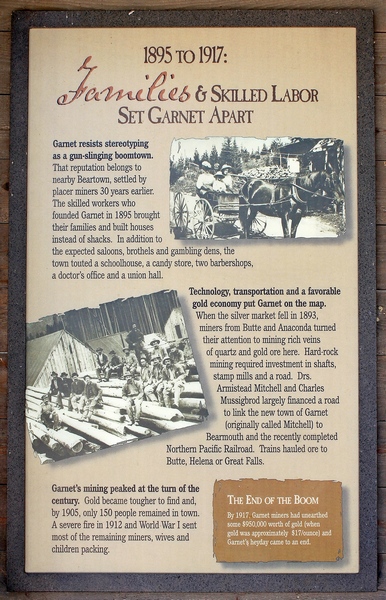 |

in the Garnet Range in
Granite
County, MT
click here for Garnet
Ghost Town location on Google Maps
Garnet is an historic mining town in west central Montana at
an elevation of 6000 ft. Originally named "Mitchell", Garnet grew up around the time
of change from placer mining to hard rock mining in the
Garnet Range. A stamp mill to crush gold ore was built by
Dr. Armistead Mitchell at the head of
First Chance Gulch in
1895. At the same time, Dr. Mitchell and Dr. Charles Mussigbrod financed a road to link "Mitchell" to
Bearmouth
and the recently completed Northern Pacific Railroad. Two
years later, the town became known as "Garnet" after the
ruby-colored, semi-precious stone found in the area.
Eager miners and
entrepreneurs built quickly and without planning. A
haphazard community resulted. Most of the buildings stood on
existing or future mining claims, and about twenty mines
operated.
Shortly after Mitchell's
stamp mill was built, Sam Ritchey hit a rich vein of ore in
his Nancy Hanks mine just west of town. That's when the
"boom" really began. By January 1898, nearly 1000
people resided in Garnet. The Nancy Hanks yielded
about $300,000 worth of gold.
The town attracted more
families than did Montana's earlier mining camps.
Garnet had four stores, four hotels, three livery
stables, two barber shops, a union hall, a school with 41
students, a butcher shop, a candy shop, a doctor’s office,
an assay office, and thirteen saloons.
By 1905, many of the
mines were abandoned and the town’s population had shrunk to
about 150. In 1912, a fire in the business district
destroyed may commercial buildings and most remaining
residents moved away. By the 1940’s, Garnet was a
ghost town.
Smaller nearby towns/mining camps of Beartown, Reynolds
City, Springtown, and Yreka got their starts 30 years
earlier in 1865 when prospectors found gold in Bear Gulch
and Elk Creek. Like the other nearby towns, Garnet had
grown up very fast without much effort given to
underpinnings like building foundations or fire
suppression.. Consequently, over time, buildings
either burned, shifted and/or collapsed. |
|
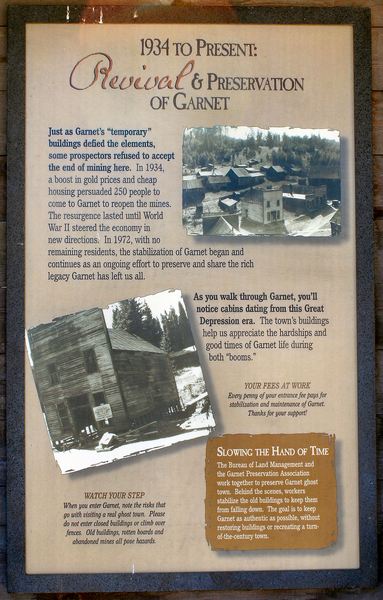 |
|
Families and skilled labor set Garnet apart from
rowdy towns like Beartown between 1895 to 1917.
Garnet mining peaked at the turn of the century. |
For more history, see
http://garnetghosttown.org/history.php
|
Revival and preservation of Garnet from 1934 to
the present.
Sign seen at the parking lot to Garnet Ghost Town. |
From Missoula, drive east on I- 90, take
Bonner exit MT-200 E to Garnet Range Rd 30 min (28.6 mi) Follow
Garnet Range Rd to your destination 30 min (12 mi) Garnet,
MT. $3 a person over 16 years of age.
Free entry for those with 'America the Beautiful' annual pass;
Senior & access passes.
|
Pictures taken 5/22/17 and 5/27/17
all photos by Andy Christen
click on the images to enlarge |
Garnet is open year-round daily from 9:30am-4:30pm, however,
access is limited in the winter. Wheeled vehicles are allowed on the road
from May 1 - January 1, depending on snow conditions. In
winter, Garnet is only accessible by snowmobile & cross-country
ski trip.
|
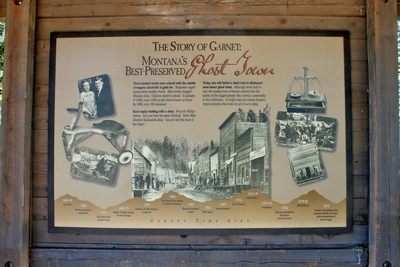 |
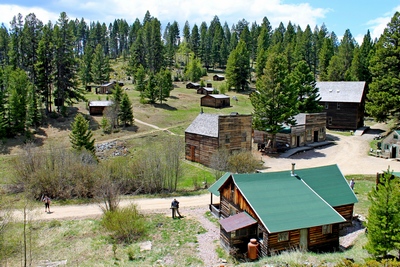 |
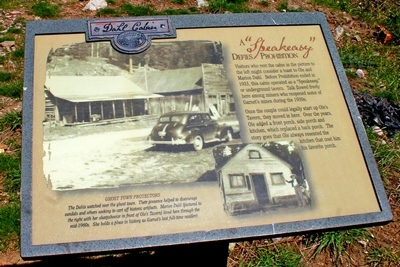 |
|
Sign just off the parking
lot. The Story of Garnet, Montana's Best Preserved Ghost
Town. Follow a short trail to Montana's most intact ghost
town. This sign shows an interesting picture of what
Garnet really looked like at the turn of the century. |
|
|
Overview of most structures seen upon entering
Garnet (ghost town) by foot from the parking lot. In
the foreground was the remodeled home of Ole and Marion Dahl
who moved there in 1938.
They built their own saloon, Dahl's Bar, just down the
street.
This cabin can be rented in the winter. |
|
|
Sign in front of the former home of Ole and
Marion Dahl, shown in the foreground of the picture to the
left. Before 1933, it was a 'Speakeasy'. Marion
Dahl, who lived here through the mid-1960s, holds a place in
history as the last full-time resident of Garnet. |
|
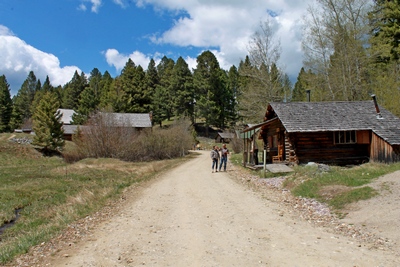 |
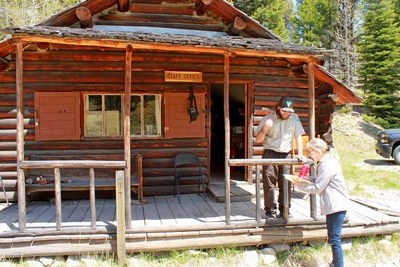 |
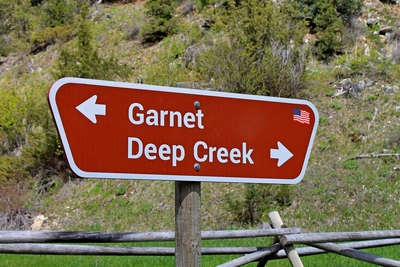 |
|
Main entrance road with the
staff office cabin on the right which is one of the better
preserved cabins but occupied for staff only. |
|
|
Diana speaks with a BLM
volunteer at the staff office cabin. Having been built
in 1949, the Bill Hübner
cabin is one of the better preserved cabins in Garnet.
For staff only... do not enter. |
|
Sign at Beartown, Montana (2.2 miles south of
Garnet) indicating which way to
Garnet Ghost Town and Deep Creek Montana |
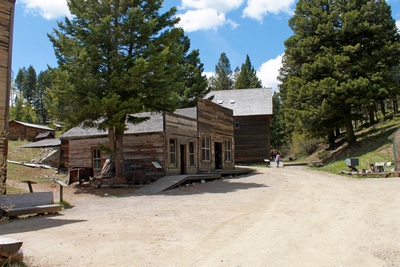 |
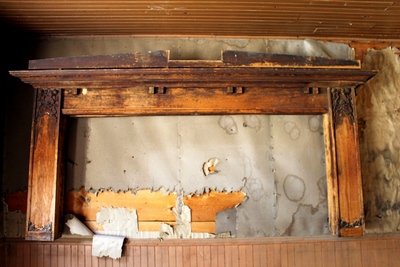 |
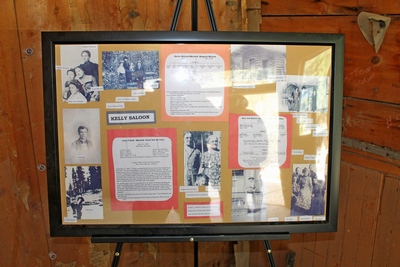 |
|
The two buildings with the
wooden walkway are the restored remains of Frank A. Davey's
store built around 1898. Behind that are the restored
remains of the J.K. Wells Hotel. To the left, outside
of the picture is the location of Kelley's Saloon. |
|
Woodwork on the wall of Kelley's Saloon, one of
the 13 bars in Garnet during the boom period that offered 'male
oriented' entertainment. |
|
Poster with pictures
describing the story of Louis P. Kelley and Sarah Ann
McLeod, owners of the property housing Kelley's Saloon. |
|
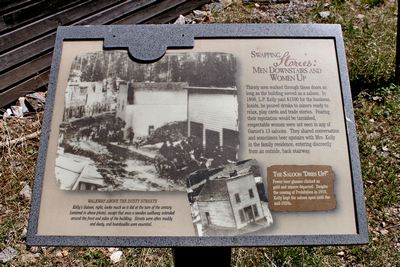 |
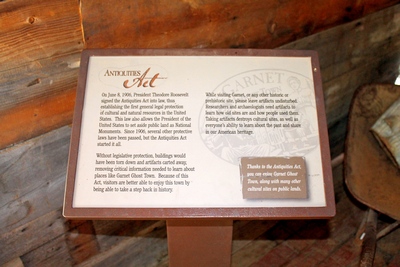 |
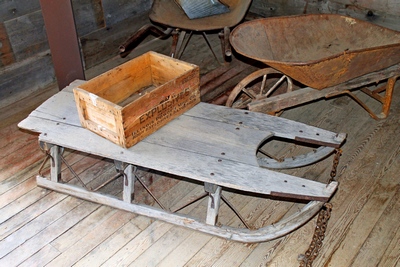 |
|
Sign outside Kelley's
saloon. L. P. Kelley paid $1500 for the business.
Inside, he poured drinks to miners ready to relax, play
cards & trade stories. A wooden walkway extended
around the front & sides. Respectable women were not seen in
any of Garnet's 13 saloons. |
|
|
Sign telling of the signing
of the 'Antiquities Act' by then President Theodore
Roosevelt in 1906 to give legal protection to cultural and
natural resources in the United States. (click to
read) |
|
Old sled and other artifacts in Frank Davey's
General Store. |
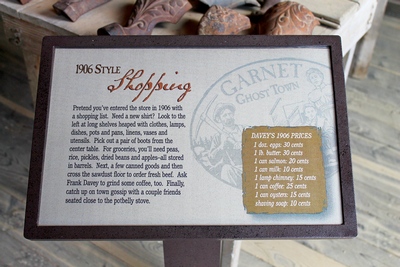 |
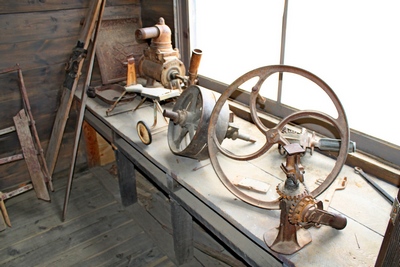 |
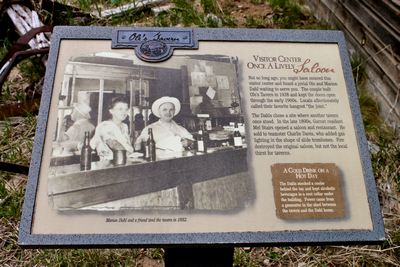 |
1906 style shopping in Frank Davey's General
Store.
(click to read) |
|
Frank Davey's General Store
sold, among other things, dry goods, shoes, jewelry, canned
goods, mining tools, and cuts of meat. The store also
had a hardware section and an office that weighed gold. |
|
|
Sign in front of Dahl's Saloon often called 'The
Joint' (now the Visitor's Center) built in 1938 by Ole
Dahl. The saloon operated until the mid-1960s.
(click to read) |
|
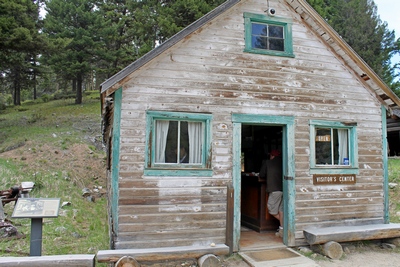 |
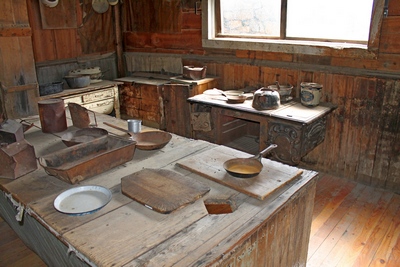 |
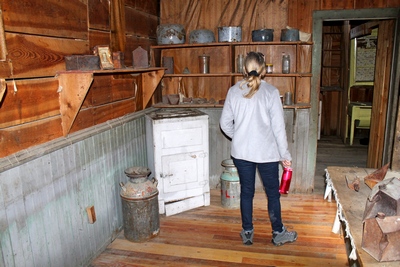 |
|
Dahl's Saloon often called 'The Joint' (now
the Visitor's Center) built in 1938 by Ole Dahl. The
saloon operated until the mid-1960s. |
|
Inside the kitchen of the Wells Hotel |
|
Diana browsing the kitchen
of the Wells Hotel in Garnet Ghost Town. |
|
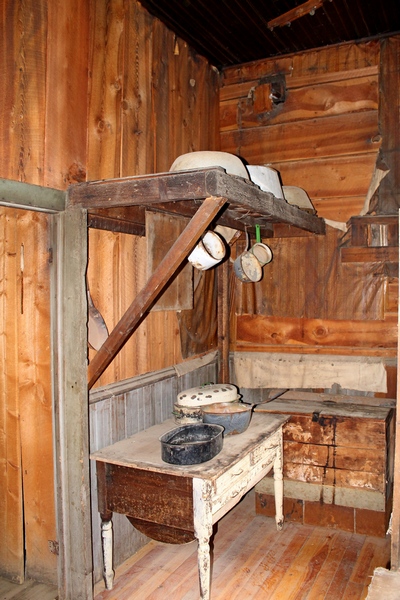 |
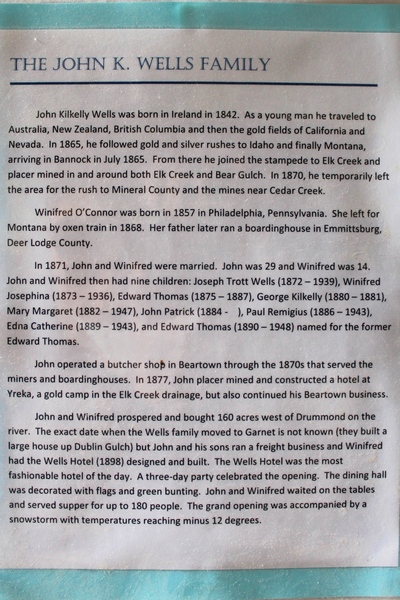 |
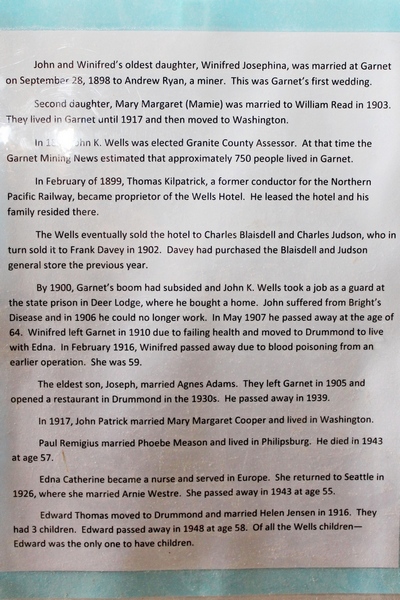 |
The Wells Hotel, kitchen prep area in the back left corner
of the kitchen.
The first floor, which included the kitchen had high ceilings. |
|
History of the John K. Wells
and Winifred O'Connor Family
in Garnet, MT (part 1) |
|
History of the John K. Wells and Winifred
O'Connor Family
in Garnet, MT (part 2) |
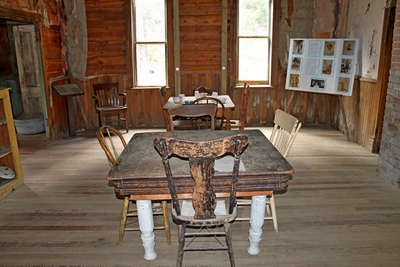 |
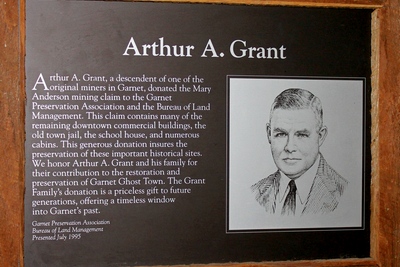 |
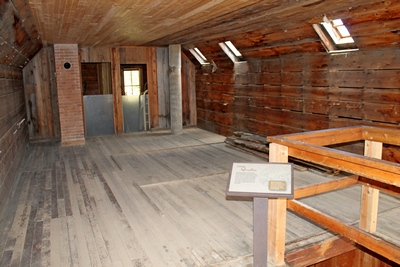 |
|
Dining area in the Wells Hotel in Garnet, MT.
Most of the remaining buildings in Garnet have been
stabilized to make it safe for visitors to explore.
Two vertical support posts can be seen in the middle of
the far wall to add rigidity to the structure. |
|
|
Arthur A. Grant, a
descendent of one of the original miners in Garnet, donated
the Mary Anderson mining claim to the Garnet Preservation
Association. The Grant family's donation is a
priceless gift to future generations, offering a timeless
window into Garnet's past. |
|
|
In the Wells Hotel, the poorer miners walked up the stairs past private,
wallpapered rooms and soft beds to the common quarters of the
top floor where there were no beds. This 3rd floor had 4
or 5 separate rooms and 3 skylights
& was heated only by the warm air from below. |
|
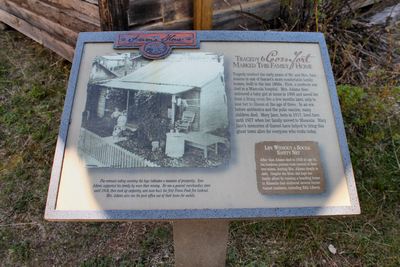 |
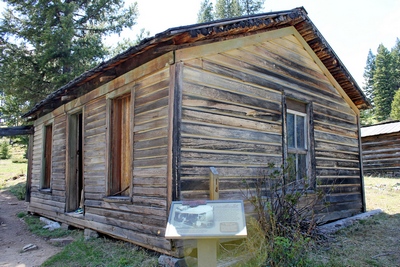 |
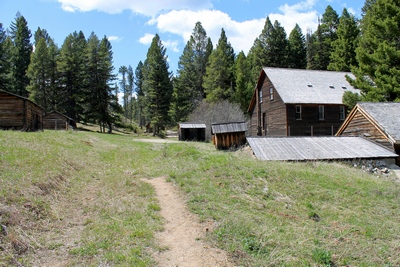 |
|
Sign in the front corner of
the Adams house. Tragedy and comfort marked this
family home. First, a newborn son died in a Missoula
hospital. Then, the family lost a girl at the age of
3. A third child,
Mary Jane, born in 1917 survived until 2011. |
|
|
The Adams house was built
between 1896 and 1900. It was among the nicer homes in
Garnet although constructed from logs, not boards as it
appears. The family lived there from 1904 to 1927.
Mrs. Adams had the Post Office in the house until 1910. |
|
|
The road just behind the
main road through Garnet. At the turn of the century,
this area was filled with buildings on both sides, as one
can see in the map of Garnet depicted below. |
|
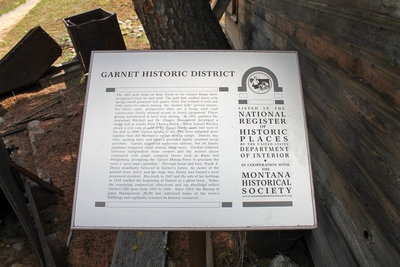 |
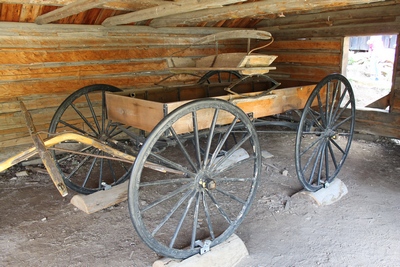 |
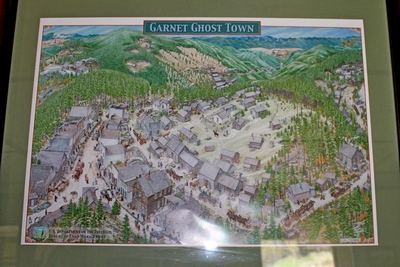 |
Garnet Historic District Sign telling the history
of Garnet
(click to read) |
|
During World War 1, Frank
A. Davey acquired this building (next to the Visitor's
center) and turned it into a livery shed. He stored
his stage coach inside. |
|
Framed & matted 3D depiction map of the original
Garnet, MT hangs on the wall in the Visitor's Center cabin. |